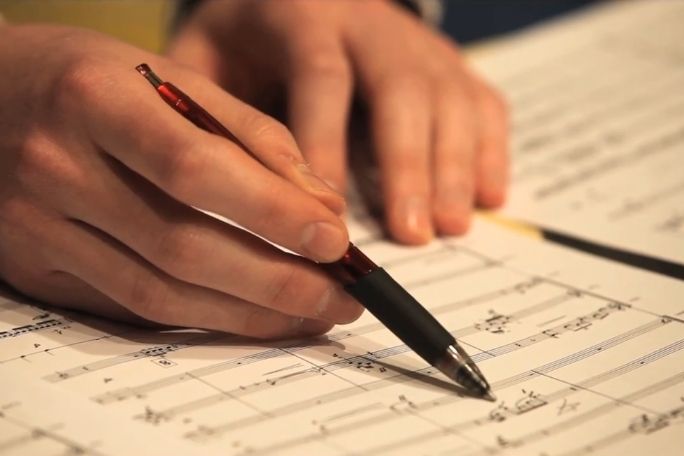Lesson summary
This lesson is designed to provide students with the knowledge and skills to enter the Fanfare Competition. They will build their understanding of orchestral score conventions and short score composing through studying past examples of winning fanfare entries. Students will explore the competition details and complete an entry in their own time.
Learning intentions:
Students will...
- consider the role of fanfare and create their own attention-grabbing music
- build their capacity to be creative and express ideas musically.
Success criteria:
Students can...
- define 'fanfare'
- identify orchestral score conventions
- recognise short score compositions.
Lesson guides and printables
Lesson details
Curriculum mapping
Australian Curriculum content descriptions:
Year 7 & 8 Music:
- Analyse composers’ use of the elements of music and stylistic features when listening to and interpreting music (ACAMUR097).
Year 9 & 10 Music:
- Evaluate a range of music and compositions to inform and refine their own compositions and performances (ACAMUR104).
Syllabus Outcomes: MUS5.7, MUS5.8, MUS5.9, MUS5.10, MUS4.7, MUS4.8, MUS4.10.
General capabilities: Critical and Creative Thinking
Relevant parts of Year 7 and 8 achievement standards: By the end of Year 8, students identify and analyse how the elements of music are used in different styles and apply this knowledge in their performances and compositions. They evaluate musical choices they and others from different cultures, times and places make to communicate meaning as performers and composers.
Students manipulate the elements of music and stylistic conventions to compose music. They interpret, rehearse and perform songs and instrumental pieces in unison and in parts, demonstrating technical and expressive skills. They use aural skills, music terminology and symbols to recognise, memorise and notate features, such as melodic patterns in music they perform and compose.
Relevant parts of Year 9 and 10 achievement standards: By the end of Year 10, students analyse different scores and performances aurally and visually. They evaluate the use of elements of music and defining characteristics from different musical styles. They use their understanding of music making in different cultures, times and places to inform and shape their interpretations, performances and compositions.
Students interpret, rehearse and perform solo and ensemble repertoire in a range of forms and styles. They interpret and perform music with technical control, expression and stylistic understanding. They use aural skills to recognise elements of music and memorise aspects of music such as pitch and rhythm sequences. They use knowledge of the elements of music, style and notation to compose, document and share their music.
Unit of work: Artology Fanfare Competition.
Time needed: 60 – 120 minutes.
Level of teacher scaffolding: High – teacher requires musical knowledge to guide student ideas.
Resources required
- Student Worksheet, one per student
- Y-Chart Worksheet – printed, one per student
- Beethoven_Symphony No.3_Mov 1_piano score_pp1-2
- Beethoven_Symphony No.3_Mov 1_full score_pp1-5
- Device capable of presenting a video to the class, manuscript paper
- Optional: Fanfare Competition DIY Student Toolkit
- Music publishing software (e.g. Finale or Sibelius) might be used to time and finalise composition, then create an MP3 version
Skills
This lesson is designed to build students’ competencies in the following skills:
- Critical thinking
- Problem solving
- Communication
- Creativity
Additional info
This lesson is part of the Fanfare Competition unit. The unit is designed for students to build their aural and technical skills while exploring music as an art form through listening, composing and performing. Students are encouraged to apply their learning by planning and organising a composition for the Fanfare Competition.
The competition encourages young people aged 12‐21 years to write a new work to be recorded by the Australian Youth Orchestra and played in venues across Australia to replace the ‘cue bells’ for audiences to take their seats. It is a wonderful way to showcase young artists and musicians, and encourage creativity in young people.


Welcome back!
Don't have an account yet?
Log in with:
By signing up to Cool.org you consent and agree to Cool's privacy policy to
store, manage and process your personal information. To read more, please see
our privacy policy here(Opens in new tab).
Create your free Cool.org account.
Many of our resources are free, with an option to upgrade to Cool+ for premium content.
Already have an account?
Sign up with:
By signing up to Cool.org you consent and agree to Cool's privacy policy to
store, manage and process your personal information. To read more, please see
our privacy policy here(Opens in new tab).